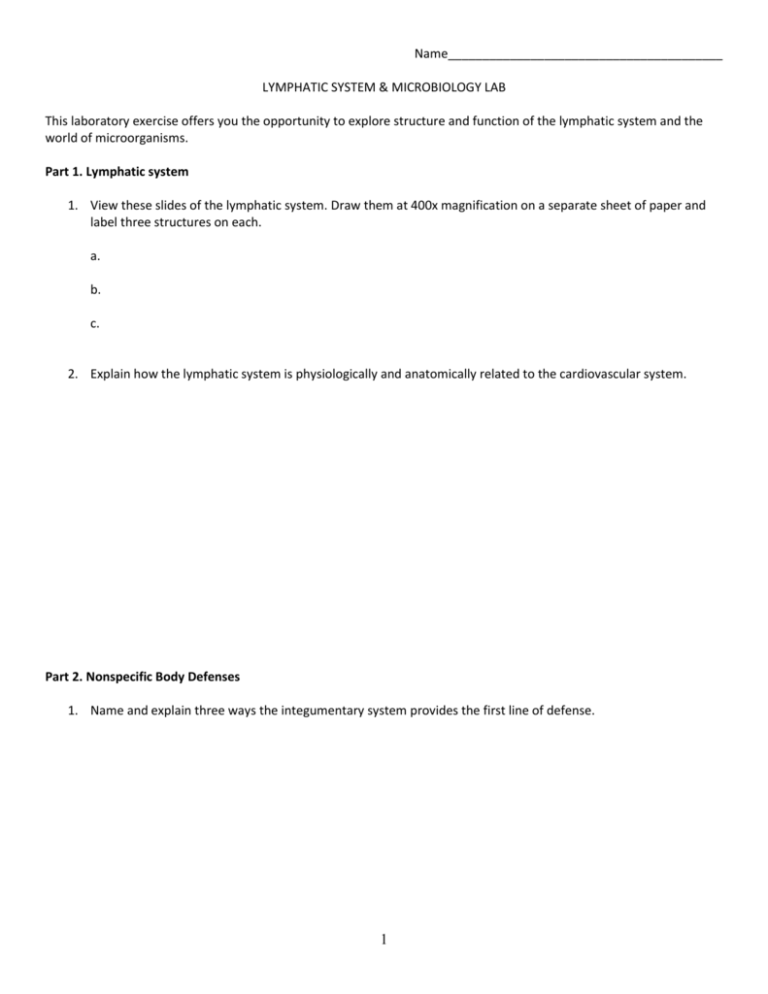Lymphatic-System-Microbiology-Lab-Fa
advertisement

Name________________________________________ LYMPHATIC SYSTEM & MICROBIOLOGY LAB This laboratory exercise offers you the opportunity to explore structure and function of the lymphatic system and the world of microorganisms. Part 1. Lymphatic system 1. View these slides of the lymphatic system. Draw them at 400x magnification on a separate sheet of paper and label three structures on each. a. b. c. 2. Explain how the lymphatic system is physiologically and anatomically related to the cardiovascular system. Part 2. Nonspecific Body Defenses 1. Name and explain three ways the integumentary system provides the first line of defense. 1 2. Draw lines matching the phrases in Column A with one term or phrase in Column B. There may be more than one connection. Column A Column B Have microbial activity Lysozymes Provide mechanical barriers Mucus Entraps microorganisms entering the respiratory passages Acids Part of the first line of defense Protein-digesting enzymes Provide chemical barriers Sebum Skin 3. Explain the protective role of cilia. From what cellular structure do cilia arise? 4. Phagocytosis a. Define and sketch the process of phagocytosis. 2 b. Name and sketch two cell types that perform phagocytosis. 5. Explain the three components of the inflammatory response. 6. Explain how complement kills bacteria. 3 Part 3. Specific Body Defenses 1. Describe the concept of an antigen and how it relates to self and non-self-markers. 2. What is the major histocompatibility complex? 3. The immune system is supposed to defend you from harmful microorganisms. Why doesn’t it always work? In other words, why do some get sick and die? 4 4. Describe how a particular blood antigen composition would respond to receiving a non-compatible blood type (the transfusion reaction). Part 4. Microbiology 1. Bacteria. From the slides provided to you today, choose two types of bacteria you are interested in. a. View on oil immersion, and sketch, on a separate sheet of paper, as well as you can. b. Find your bacteria names on the Bacterial Classification Chart. You will see them listed by genus, the first word in the scientific name. c. “Characterize” your bacteria type using the chart and the example below. In the chart, commonly-found and easily-grown genera of bacteria are sorted out based on various "primary tests". Since most details on bacterial cell structure cannot be discerned using light microscopes (bacteria cells are so small, about the size of a mitochondrion) this system is used. Characterization example: Pseudomonas aeroginosa: A gram negative aerobic rod-shaped bacterium which does not form endospores, it performs catalase, benzidine and oxidase reactions and does not metabolize glucose. This description comes from finding the bacterial type on the chart, finding the column with the “X” then following the “X” up. The description written in +, -, or words tells you the characteristics of the bacterial type. Plus mean it does or has that quality, minus means that action or quality is absent. Notes: The benzidine test determines the presence of iron-porphyrin compounds such as cytochromes. Some organisms possess the enzyme cytochrome a3 oxidase as part of the electron transport system in respiration. The Gram staining method is one of the most important staining techniques in microbiology. It is almost always the first test performed for the identification of bacteria. Gram staining is based on the ability of bacteria cell wall to retain crystal violet dye during treatment. The cell walls for Gram-positive 5 microorganisms have a higher peptidoglycan and lower lipid content than gram-negative bacteria. Gram+ cells absorb more dye and appear purple, Gram- cells absorb less and appear pink. Anaerobic vs. aerobic growth distinguishes types of metabolism as without oxygen or with. Endospores, cells with tough coverings, form in some bacteria allowing dormancy for long periods of time. Please note: not all life utilizes carbohydrates (in the form of glucose in this chart) for energy. Write your two characterizations here. Part 5. Concept Map Consider the skeletal system, cardiovascular system. muscular system, and immune system. Construct a concept map showing how the immune system relates to each of the others in at least one way. Be sure to add explanation on each connecting line to make your reasoning clear. 6





